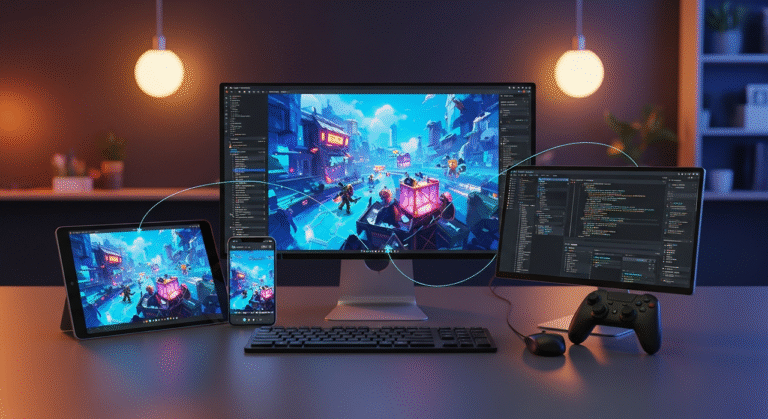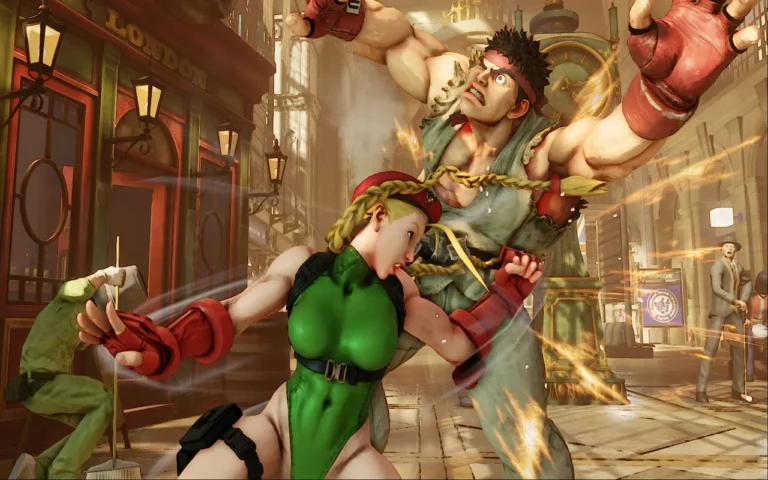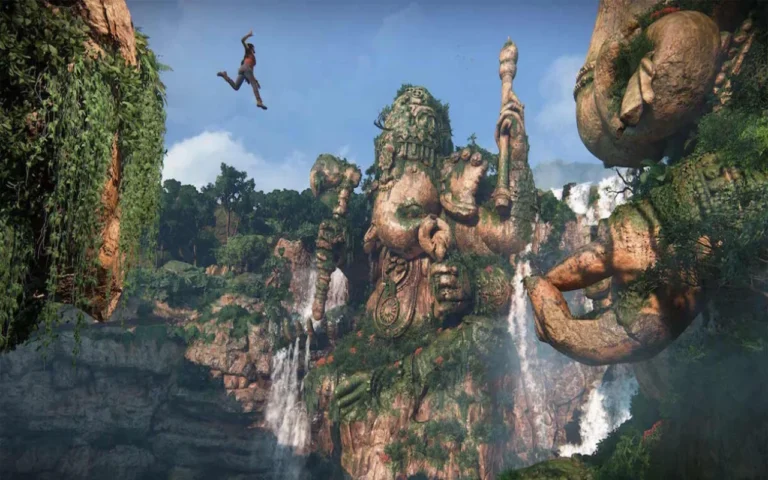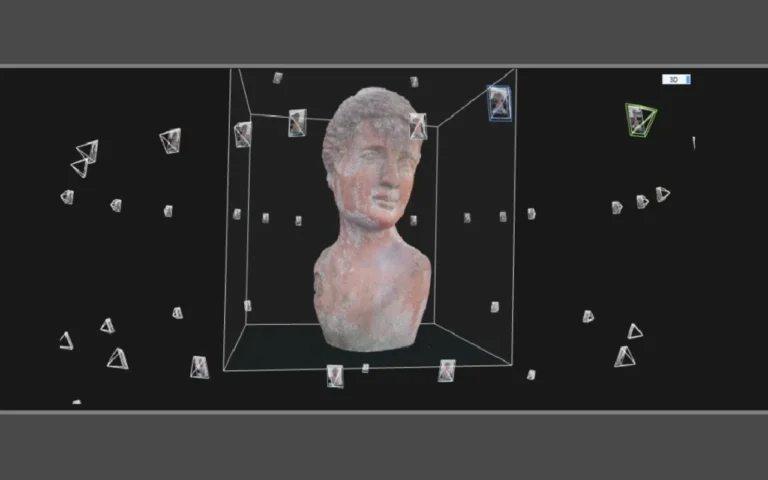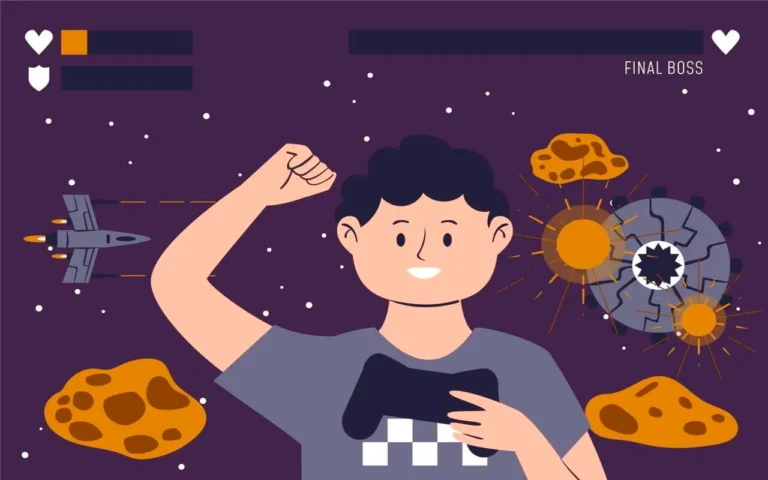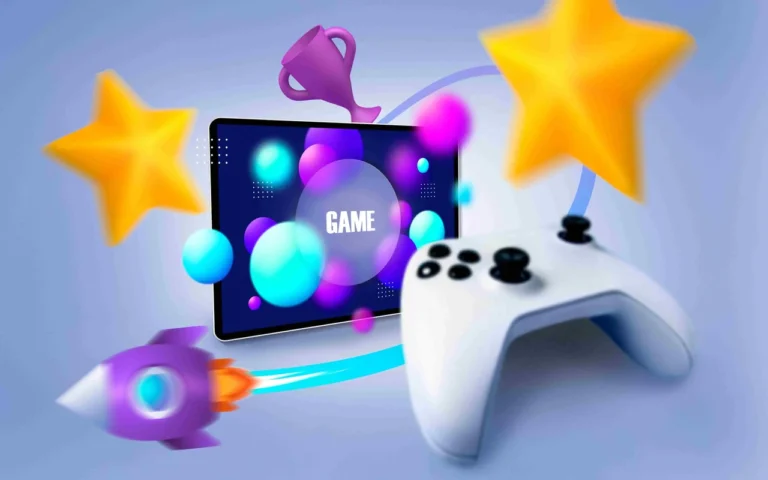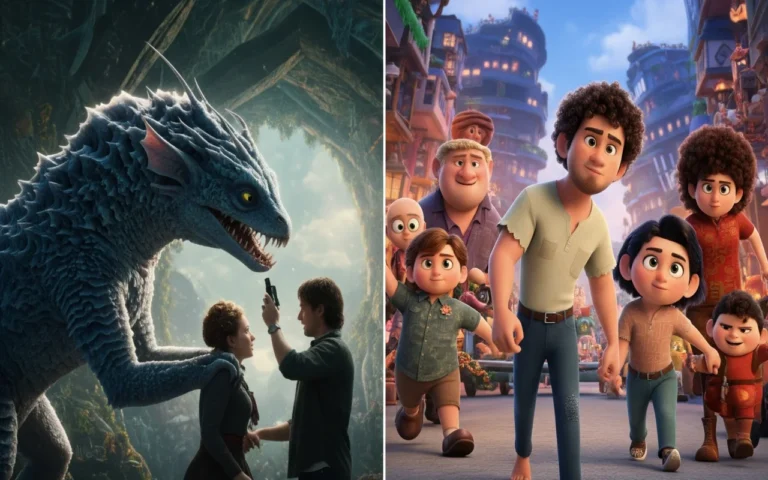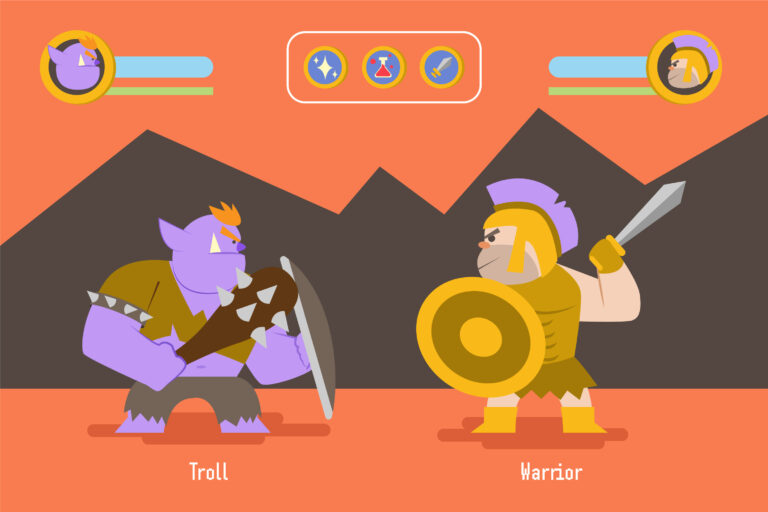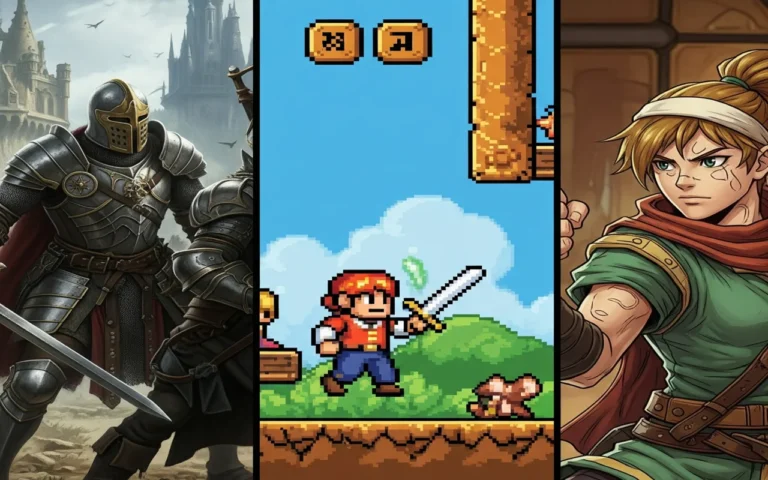The visual foundation of video games game art consists of everything you see on the screen while playing. Games come to life in the vibrant universe of people, settings, objects, and user interfaces.
Every piece of game art, from the tiny pixel models in old classics to the most jaw-dropping 3D settings in new hits, helps players get lost in virtual worlds. Idea art, 2D art, 3D modeling, animation, and UI design are all parts of this field.
Game art should be considered the secret ingredient that transforms a basic game mechanism into an eye-show feast. It’s what draws gamers to pause in their steps to savor an amazing view in an open-world game or fall in love with a unique character design.
For instance, “Minecraft’s lovely, low-poly graphic style has become legendary and shows that even basic bricks can build a visually striking cosmos. On the other hand, “The Last of Us Part II” and other highly realistic character models and environs blur the border between the game and reality.


Need Game Art Services?
Visit our Game Art Service page to see how we can help bring your ideas to life!
10 Types of 3D Game Art
Here are the most famous types of 3D art:
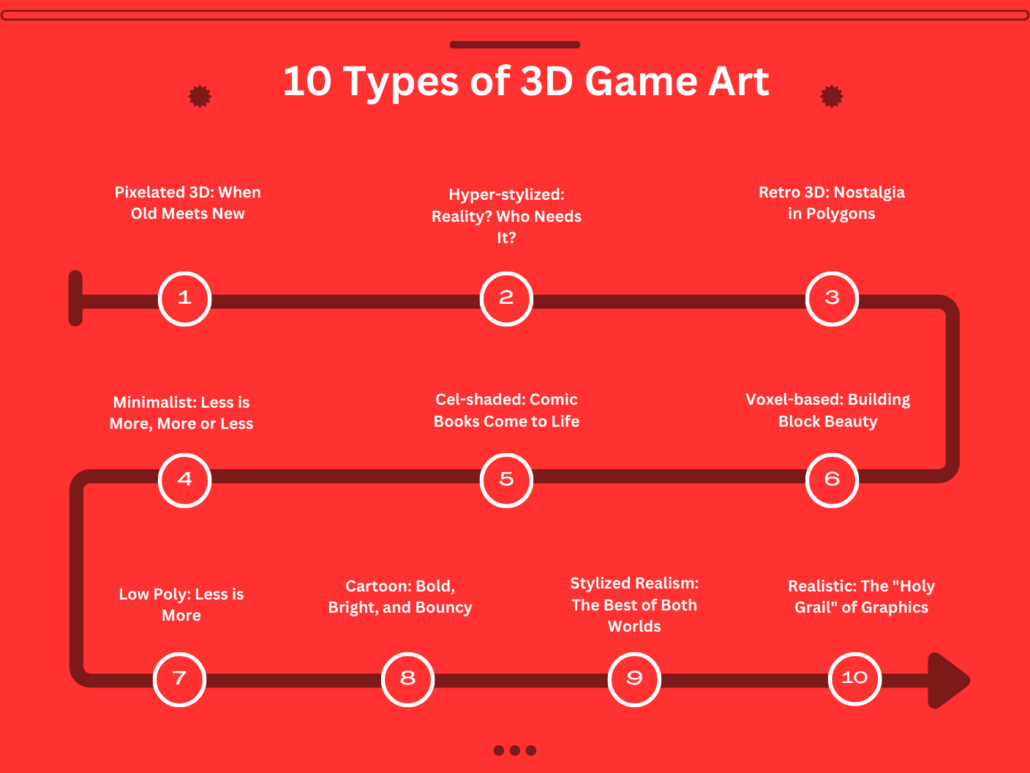
1- Realistic: The "Holy Grail" of Graphics
Imagine going through a virtual world that looks and feels so real that you forget you’re playing a game. Realistic 3D art seeks to do just that. With their amazing settings and finely drawn characters, you could count their pores; games like “Red Dead Redemption 2” master this approach. It’s all about those high-resolution textiles and elegant lighting strategies that cause you to ask, “Wow, is this real life?”
2- Stylized Realism: The Best of Both Worlds
Consider this as reality twisted differently. One flawless example is “The Legend of Zelda: Breath of the Wild“. Link and his surroundings seem reasonable, yet everything has a magical, almost exaggerated aspect. It’s as if reality had a lovely makeover, still familiar but with a little more imagination thrown in.
3- Cartoon: Bold, Bright, and Bouncy
Think back on Saturday morning cartoons. Here the atmosphere is like that. Games like “Fortnite” rock this approach with their vivid colors and larger-than-life figures. Everything seems a little overdone, with too dramatic characteristics that just make you want to grin. It’s like entering your preferred animated series.
4- Low Poly: Less is More
This approach shows that you don’t need a million polygons to look decent. One such great example with its sharp, angular design is “Superhot“. The gaming environment seems to be created of sharp crystals or folded paper. The simplicity here is beautiful; clean lines and strong colors that carry a visual impact.
5- Voxel-based: Building Block Beauty
If you have played “Minecraft,” you know exactly what this looks like. Everything is composed of cubes, like a digital Lego-built universe. Though basic, these blocky worlds have a strangely fulfilling quality. As a result, they reawaken the imaginative and exploratory spirit of our inner kid.
6- Cel-shaded: Comic Books Come to Life
Always wished to enter a live, breathing cartoon? Cel-shading makes things like that. The “Borderlands” series masters this look. Someone took a comic book and somehow brought it to life on your screen.
Everything features black, sharp edges and flat colors that catch your eye immediately away. It makes you feel like you’re playing through an animated film, vivid and entertaining. The characters really are very amazing; they seem like they might have strolled right out of a comic book.
7- Minimalist: Less is More, More or Less
One flawless example of a Minimalist approach done well is “Journey.” It only has a few colors and simple shapes, but does it make me feel something? The people who made the game must have thought, “How little can we show and still tell a strong story?”
Simply put, the result is incredibly beautiful. It’s evidence that sometimes you don’t need all the bells and whistles to produce something really remarkable.
8- Retro 3D: Nostalgia in Polygons
Recall those early 3D games that, in the day, astounded us? Retro 3D style is about catching that enchantment. Games like “Dusk” take you back to the late 90s, when 3D visuals were fresh and fascinating.
It has chunky polygons, hazy textures, and a very lovely “early 3D” appearance. Gamers from that generation can’t get enough of it; it brings back fond memories of cuddling up with buddies in front of a CRT TV
9- Hyper-stylized: Reality? Who Needs It?
After one glance at reality, this approach declares, “Nah, we’re heading off the deep end!” The poster son for this strategy is “Team Fortress 2“. Characters have overdone traits that ought not to be there but yet nevertheless are. Environments seem to come from some fever dream, and proportions are tossed out the window. It’s arrogant and doesn’t mind breaking the rules. Playing a game using this approach is like entering a realm in which the creators let their creativity run wild.
10- Pixelated 3D: When Old Meets New
Think about how cute it would be to incorporate the nostalgia of classic pixel graphics into 3D models in some way. 3D Dot Game Heroes” is the ideal illustration. It looks like someone made a 3D world out of little colored blocks. The outcome is this unusual mix of nostalgia and contemporary technology that seems rather fulfilling. While it looks like old-school pixels, it has the depth and action of 3D images.
Read More: Exploring 3D Art Styles for Games
10 Types of 2D Game Art
Now is the time to go through 2D art.
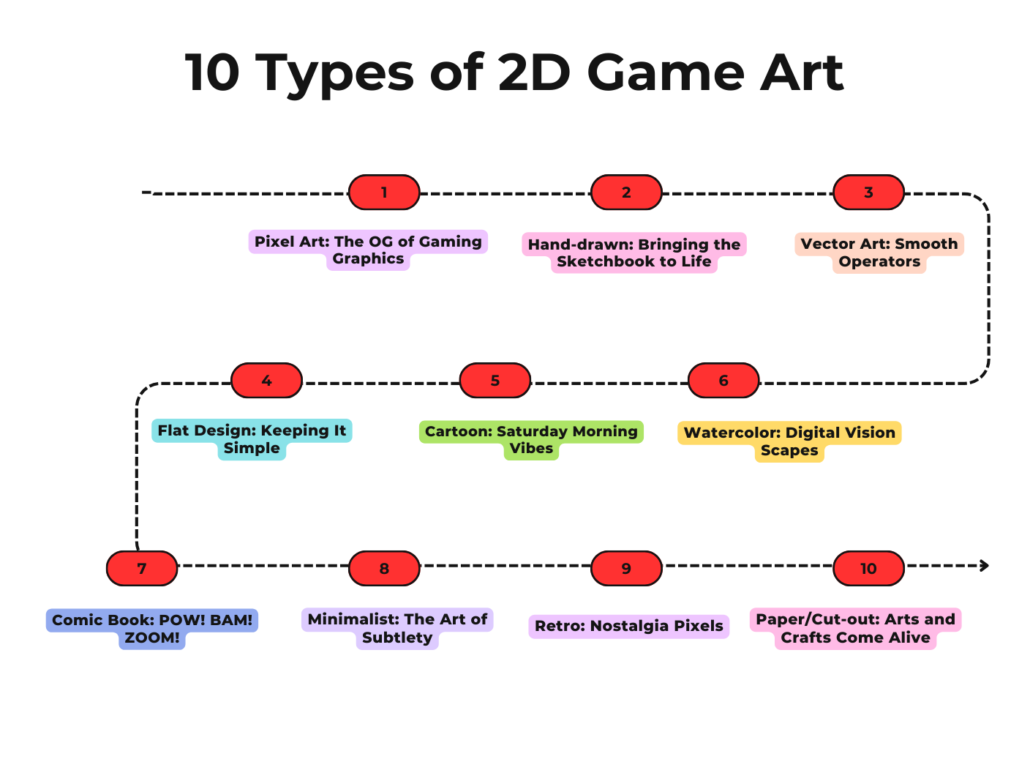
1- Pixel Art: The OG of Gaming Graphics
Can you still see every square in those old-school games? That is pixel art. Modern masterpieces of this kind include “Stardew Valley.” Each dot counts, much as in digital pointillism!
While some pixel art, like “Stardew,” is so beautiful you forget you’re gazing at little squares, others are rather plain, like the ancient Atari days. You wouldn’t believe how much personality artists can fit into a few pixels!
2- Hand-drawn: Bringing the Sketchbook to Life
The feeling of hand-drawn game art is like if your doodles started moving out of the blue. One such lovely example is “Hollow Knight.” Like the painters grabbing their pencils frame by frame, bringing an entire universe to life. You would believe the characters were alive because the animations are so seamless. That personal touch gives you the sensation of playing via someone else’s imagination.
3- Vector Art: Smooth Operators
Those neat, clear lines that look great at any scale define vector art. Think “Angry Birds,” those pigs and birds always seem crisp on a little phone or a large TV. Vector art remains sharp no matter how much you zoom in, unlike a jpg or emoji. It also has this really enticing, contemporary, sleek attitude.
4- Flat Design: Keeping It Simple
When it comes to game art, the flat style is like the Zen master. “Thomas Was Alone” accomplishes this look. Simple forms and plain colors rule here; no elaborate shadows or textures! But let the simplicity not mislead you. These games may be really interesting and emotional. It’s evidence that sometimes less truly is more.
5- Cartoon: Saturday Morning Vibes
The game cartoon style is like entering your preferred animation series. As an example, “Cuphead” makes your game system look like a cartoon from the 1930s. Characters have great faces and flamboyant motions; they are all bouncy and overdone. It’s pure, genuine enjoyment that helps you to feel like a child once again.
6- Watercolor: Digital Vision Scapes
Watercolor-style games such as “Child of Light” allow one to experience a moving painting. Everything has this really hypnotic and softly dreamy aspect. The way the colors mix and flow generates moods ranging from serene to enigmatic to rather beautiful. This type of artistic expression makes you want to stop the game in order to appreciate the surroundings.
7- Comic Book: POW! BAM! ZOOM!
Comic book design comes directly to your computer, the vitality of graphic novels. One famous example is the “Comix Zone.” You have strong lines, vivid hues, and sometimes even those quirky action phrases bursting out when you strike anything. It makes you feel like the star of your comic adventure; it’s lively and thrilling.
8- Minimalist: The Art of Subtlety
Simple games like “Limbo” show that a strong ambiance may be created without dazzling visuals. It’s all about simplifying things to their very minimum. The only colors in “Limbo” are black and white, but does it matter? It’s amazing how little can pack so much feeling and story.
9- Retro: Nostalgia Pixels
The retro look seems like a time warp returning to the heyday of gaming. “Shovel Knight” captures this appearance and feels as if it might have come directly from a NES. It has restricted color palettes, chunky pixel appeal, and simple designs that yet convey great emotional expression. This is a love letter to the games most of us grew up with.
10- Paper/Cut-out: Arts and Crafts Come Alive
The “Paper Mario” series gives you the impression of being played inside a diorama. Everything seems to have been glued into this lovely, complex universe from paper. Its tactile character appeals to you, making you want to reach out and touch the screen. Looking at it is quirky, artistic, and just plain enjoyable.
What Is the Role of a Game Artist?
These creative professionals are the unsung heroes who bring our favorite virtual worlds to life. Here’s a detailed look at the different hats they wear:
- The visionary who sets the visual tone for the entire game
- Creates initial sketches of characters, environments, and key objects
- Develops color palettes and overall art direction
- Often works closely with game designers to visualize gameplay elements
2- Character Artist
- Designs and models the game’s characters in detail
- Creates both main protagonists and background NPCs
- Responsible for character customization options
- May also handle character rigging for animation
3- Environment Artist
- Builds the world that players will explore
- Creates landscapes, buildings, and atmospheric elements
- Ensures the game world feels cohesive and immersive
- Often collaborates with level designers for gameplay integration
4- Texture Artist
- Adds surface details to 3D models
- Creates and applies textures to characters, objects, and environments
- Responsible for making models look realistic or stylized
- Works with various texture maps (diffuse, normal, specular, etc.)
5- UI/UX Artist
- Designs the game’s user interface
- Creates menus, HUDs, icons, and other on-screen elements
- Ensures the interface is both functional and visually appealing
- Works to make the UI intuitive and aligned with the game’s overall style
6- VFX Artist
- Creates visual effects like explosions, magic spells, weather, etc.
- Uses particle systems and shader effects
- Enhances the visual impact of gameplay actions
- Collaborates with sound designers for audiovisual harmony
7- Animator
- Brings characters and objects to life through movement
- Creates animations for characters, creatures, and interactive elements
- Works on both gameplay animations and cutscenes
- Collaborates closely with riggers and gameplay designers
8- Art Director
- Oversees the entire art team and maintains visual consistency
- Makes high-level decisions about the game’s artistic direction.
- Manages art pipelines and ensures deadlines are met
- Collaborates with other department heads to align art with overall game vision
9- 2D Artist
- Creates scenes, textures, and 2D assets for games.
- Design UI elements, promotional art, and in-game illustrations
- May work on both digital and traditional mediums
- Often vital for 2D games or games with 2D elements
Read More: 13 Game Artist Careers: All You Need to Know
Top Best Tools and Software for Game Art
Many artists mix and match these tools to create their digital masterpieces. It’s all about finding what works best for you and your game’s art style!
Category | Popular Software | What It’s Used For |
|---|---|---|
2D Art | Photoshop,
Krita,
Clip Studio Paint, | Creating textures, concept art, and 2D game assets. |
3D Modeling | Maya,
Blender,
3ds Max, | Sculpting characters, environments, and objects in 3D. |
Animation | Maya,
Blender,
Spine, | Bringing characters and objects to life with movement. |
Texturing | Substance Painter,
Mari,
Quixel Mixer, | Adding color and surface details to 3D models. |
Game Engines | Unreal Engine,
Unity,
Godot, | Where it all comes together. |
VFX | Houdini,
Nuke,
After Effects, | Creating special effects like explosions and magic. |
UI/UX | Adobe XD,
Figma,
Sketch, | Designing user interfaces and menus. |
Pixel Art | Aseprite
PyxelEdit | Crafting retro-style graphics pixel by pixel! |
How is the Process of Creating Game Art?
It’s going to be a wild ride through the game art pipeline. Every level gives the game gumbo more taste, like preparing a visual feast!
1- Concept art: The Indulterater
The magic begins at this place. Artists create paintings and drawings that capture the essence of the whole game. I mean, just think of how crazy it would be if the creators of “Horizon Zero Dawn” came up with those robot dinosaurs. It’s all about perfecting the ambiance and energizing everyone about the game’s appearance.
2- Modeling in 3D: Crafting the Main Course
We are now cooking with gas. 3D artists begin creating items, settings, and characters. They use software like Maya or Blender instead of a pottery wheel to make it, so it’s kind of like digital clay. Consider how carefully the people at Naughty Dog created every nook and crevice of “The Last of Us” universe.
3- Texturing: Adding the Spices
Time to bring everything to taste! Artists who work with textures add details to 3D models. This is what makes the top crispy and golden brown instead of just dough. Here, games like “Red Dead Redemption 2” excel with their well-rendered character faces and battered cowboy attire.
4- Rigging and Animation: Bringing the Dish to Life
Here digital skeletons are created by riggers, and animators produce motion. It’s similar to puppeteering, except that your strings are composed of code. Consider the smooth motions in a game like “Spider-Man”—that is all owing to these artists.
5- UI/UX Design: Setting the Table
UI artists are creating menus, HUDs, and icons as all this is occurring. The goal is to prevent gamers from experiencing any kind of headache while navigating the game. One outstanding example of UI art in action is Cyberpunk 2077’s elegant, futuristic interface.
6- VFX: The Sizzle on the Steak
The VFX team adds those amazing special effects. Explosions, magic spells, weather, all the spectacular things that cause you to “Whoa!” Games like “Control,” with their psychedelic supernatural effects, truly stretch their muscles here.
7- Lighting: Setting the Mood
Lighting artists fly in to create the mood. Being a cinematographer in an interactive environment is similar to this. The dark, neon-soaked streets of “Cyberpunk 2077” highlight the need for proper illumination.
8- Polish and Optimization: The Final Garnish
All of this exquisite art flows smoothly because of the technical artists’ magic. They are the unsung heroes ensuring your game does not become a console or PC PowerPoint show-through.
How Are The Career Paths in Game Art?
We brought you the passes with salaries, but remember that it might change, and it is not all correct:
Junior Artist
- Salary: $35,000 – $55,000
- What they do: Create smaller assets, learn the ropes, and assist senior artists.
- Path: Fresh graduates, career switchers.
Mid-level Artist
- Salary: $55,000 – $75,000
- What they do: Handle bigger projects, maybe lead small teams, specialize in certain areas.
- Path: 2-5 years experience.
Senior Artist
- Salary: $75,000 – $110,000
- What they do: Create key assets, mentor juniors, and make important creative decisions.
- Path: 5+ years experience.
Lead Artist
- Salary: $90,000 – $130,000
- What they do: Manage art teams, set visual direction, and ensure quality and consistency.
- Path: Usually 7+ years experience.
Art Director
- Salary: $110,000 – $160,000
- What they do: Oversee the entire art department and set the overall visual style for games or studios.
- Path: Often 10+ years experience.
Character Artist
- Salary: $50,000 – $100,000
- What they do: Model and texture game characters, from heroes to NPCs
- Path: Master organic modeling, and you’ll be bringing digital beings to life!
Environment Artist
- Salary: $50,000 – $100,000
- What they do: Create game worlds, from sprawling landscapes to detailed interiors.
- Path: If you love crafting entire worlds, this is your jam!
UI/UX Artist
- Salary: $55,000 – $110,000
- What they do: Design user interfaces, menus, HUDs, and other on-screen elements
- Path: Blend artistic skills with user psychology for this crucial role!
Last Words
The world of game art is a vibrant and ever-evolving field that plays a crucial role in bringing video games to life. From the initial concept sketches to the final polished visuals, game artists weave together creativity and technical skill to craft immersive digital worlds.
Whether it’s through hyper-realistic 3D environments, charming 2D sprites, or stylized character designs, game art sets the visual tone that captivates players and enhances storytelling. Plus, the diverse career paths within game art offer opportunities for specialists in areas like concept art, 3D modeling, animation, and UI/UX design, each contributing their unique skills to the collaborative process of game development.

